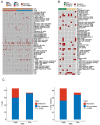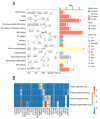Detection of Potential Mutated Genes Associated with Common Immunotherapy Biomarkers in Non-Small-Cell Lung Cancer Patients
- PMID: 36005189
- PMCID: PMC9406727
- DOI: 10.3390/curroncol29080451
Detection of Potential Mutated Genes Associated with Common Immunotherapy Biomarkers in Non-Small-Cell Lung Cancer Patients
Abstract
Microsatellite instability (MSI), high tumor mutation burden (TMB-H) and programmed cell death 1 ligand 1 (PD-L1) expression are hot biomarkers related to the improvement of immunotherapy response. Two cohorts of non-small-cell lung cancer (NSCLC) were collected and sequenced via targeted next-generation sequencing. Drug analysis was then performed on the shared genes using three different databases: Drugbank, DEPO and DRUGSURV. A total of 27 common genes were mutated in at least two groups of TMB-H-, MSI- and PD-L1-positive groups. AKT1, SMAD4, SCRIB and AXIN2 were severally involved in PI3K-activated, transforming growth factor beta (TGF-β)-activated, Hippo-repressed and Wnt-repressed pathways. This study provides an understanding of the mutated genes related to the immunotherapy biomarkers of NSCLC.
Keywords: gene mutation; immunotherapy; microsatellite instability; non-small-cell lung cancer; programmed cell death protein-1; tumor mutation burden.
Conflict of interest statement
The authors declare no conflict of interest.
Figures








Similar articles
-
Clinicopathological characteristics and the relationship of PD-L1 status, tumor mutation burden, and microsatellite instability in patients with esophageal carcinoma.BMC Cancer. 2025 Mar 31;25(1):576. doi: 10.1186/s12885-025-13938-y. BMC Cancer. 2025. PMID: 40165109 Free PMC article.
-
Assessment of Blood Tumor Mutational Burden as a Potential Biomarker for Immunotherapy in Patients With Non-Small Cell Lung Cancer With Use of a Next-Generation Sequencing Cancer Gene Panel.JAMA Oncol. 2019 May 1;5(5):696-702. doi: 10.1001/jamaoncol.2018.7098. JAMA Oncol. 2019. PMID: 30816954 Free PMC article.
-
PD-L1 expression and tumor mutational burden status for prediction of response to chemotherapy and targeted therapy in non-small cell lung cancer.J Exp Clin Cancer Res. 2019 May 14;38(1):193. doi: 10.1186/s13046-019-1192-1. J Exp Clin Cancer Res. 2019. PMID: 31088500 Free PMC article.
-
Microsatellite Instability, Mismatch Repair, and Tumor Mutation Burden in Lung Cancer.Surg Pathol Clin. 2024 Jun;17(2):295-305. doi: 10.1016/j.path.2023.11.011. Epub 2023 Dec 20. Surg Pathol Clin. 2024. PMID: 38692812 Review.
-
ESMO recommendations on microsatellite instability testing for immunotherapy in cancer, and its relationship with PD-1/PD-L1 expression and tumour mutational burden: a systematic review-based approach.Ann Oncol. 2019 Aug 1;30(8):1232-1243. doi: 10.1093/annonc/mdz116. Ann Oncol. 2019. PMID: 31056702
References
Publication types
MeSH terms
Substances
LinkOut - more resources
Full Text Sources
Medical
Research Materials
Miscellaneous

